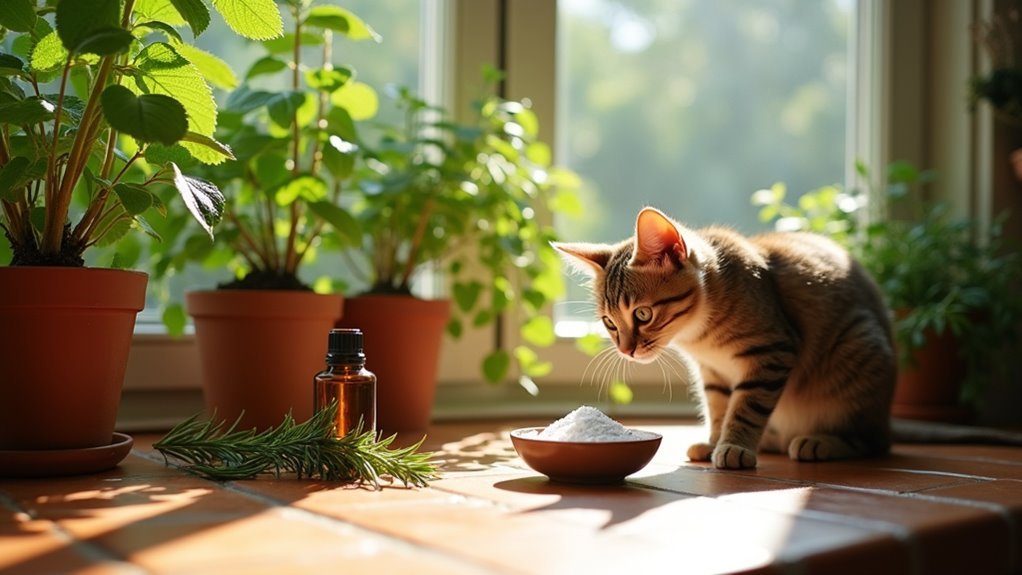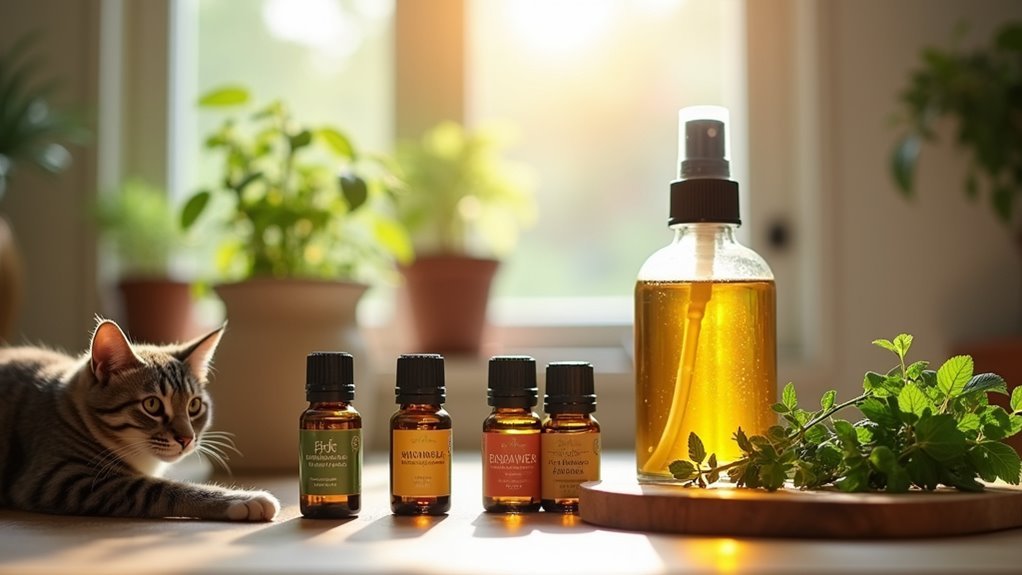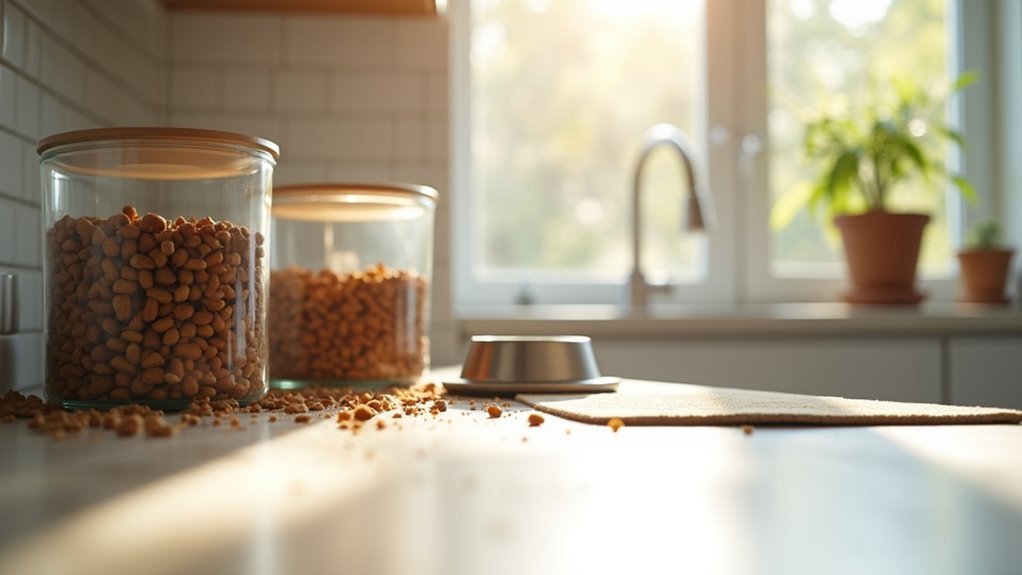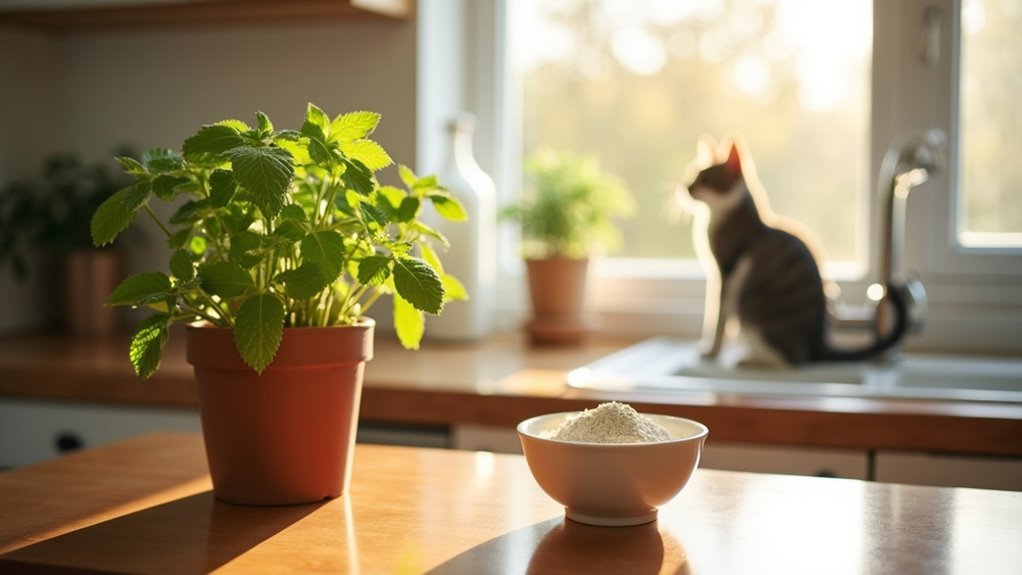You can eliminate cockroaches safely using natural repellents like peppermint oil and catnip, which disrupt roaches without harming pets. Food-grade diatomaceous earth creates microscopic abrasions that dehydrate roaches over 1-3 weeks when applied in thin layers. Regular vacuuming removes roaches and their eggs, while sealing food in airtight containers and fixing water leaks eliminates their survival resources. Pet-safe gel baits in sealed stations and strategic entry point sealing provide additional protection for thorough roach control that prioritizes your pets’ wellbeing.
Natural Repellents That Keep Roaches Away From Your Pets

When you’re dealing with a roach problem but want to keep your furry friends safe, natural repellents offer the perfect solution.
Peppermint oil diluted with water creates an effective barrier while providing a pleasant scent that disrupts roaches’ systems.
Catnip works as another powerful natural deterrent since its nepetalactone content repels cockroaches without harming your pets.
Bay leaves scattered around problem areas create strong scents that roaches actively avoid.
Food-grade diatomaceous earth damages cockroach exoskeletons through dehydration and remains completely safe for pets when applied in dry areas.
For enhanced protection, apply cedarwood oil in spaces your pets can’t access, creating an invisible barrier cockroaches won’t cross.
Food-Grade Diatomaceous Earth for Safe Roach Control
You’ll find food-grade diatomaceous earth offers an effective, chemical-free solution that’s safe around your pets when used properly.
This fine powder works by damaging roaches’ exoskeletons and dehydrating them, but you’ll need to apply it correctly in thin layers along baseboards and dark corners.
Understanding how often to reapply DE and where to place it will maximize your results while keeping your furry friends protected.
How DE Works
Food-grade diatomaceous earth acts as a natural pest control weapon by creating microscopic abrasions on cockroaches’ exoskeletons, ultimately causing fatal dehydration.
This pet-friendly roach control method works gradually, requiring several days to dehydrate cockroaches effectively. You’ll see population reduction over time as DE maintains its potency until disturbed or dampened.
When you apply in areas where roaches travel frequently, use thin layers in dry locations. Reapplication becomes necessary after cleaning or moisture exposure to maintain effectiveness.
- Gradual elimination: Takes several days to show visible results through dehydration
- Long-lasting power: Remains effective until physically disturbed or wet
- Strategic placement: Apply in dry roach pathways while limiting pet access
- Safety consideration: Minimize irritation from inhalation by controlling application areas
Safe Application Methods
Since proper application technique determines DE’s effectiveness while protecting your pets, you’ll want to focus on strategic placement and controlled distribution.
Use a duster applicator to create thin, even layers along baseboards and dark corners where roaches travel. Unlike boric acid, diatomaceous earth (DE) won’t harm your pets when applied correctly, making it ideal for pet owners seeking DIY methods.
Keep pets away during application to prevent inhalation or rolling in the dust. Focus on high-traffic roach areas rather than broadcasting everywhere.
The active ingredients work gradually, so don’t expect instant results. Reapply after cleaning or when areas become damp. This targeted approach guarantees the powder remains safe for pets while maintaining effectiveness against roaches over the 1-3 week treatment period.
Effectiveness and Reapplication
While diatomaceous earth doesn’t deliver the instant gratification of chemical sprays, it provides reliable long-term roach control that’s worth the wait. This pet safe roach killer works gradually by damaging cockroach exoskeletons, causing dehydration over 1-3 weeks.
Key effectiveness factors for DE:
- Patience pays off – You’ll see visible population reduction within 1-3 weeks as DE systematically eliminates roaches.
- Strategic placement matters – Apply in high-traffic roach areas like cracks, crevices, and baseboards for maximum effectiveness.
- Moisture kills performance – Keep treated areas dry since dampness reduces DE’s ability to kill roaches.
- Reapplication requirements – Refresh DE after cleaning or when areas get wet to maintain control.
DE remains safe for your pets throughout the process, making reapplication worry-free when maintaining your roach-free home.
Pet-Safe Gel Baits and Bait Station Placement
When you’re dealing with a stubborn roach infestation, pet-safe gel baits offer an effective solution that won’t endanger your furry companions.
These baits contain active ingredients like indoxacarb that disrupt cockroaches’ nervous systems while maintaining pets safety when properly applied.
Indoxacarb-based gel baits target roach nervous systems effectively while ensuring your pets remain safe with proper application techniques.
Choose sealed bait stations that prevent your pets from accessing harmful ingredients while still attracting roaches.
Focus your placement in areas with high roach activity—under sinks, behind appliances, and in dark corners where pets can’t reach them.
Replace bait stations every 3-4 weeks to maintain their effectiveness and keep the bait fresh.
Always follow manufacturer instructions for proper placement and application.
This approach guarantees you’re targeting roaches effectively while keeping your beloved pets completely safe from harmful exposure.
Essential Oils That Deter Cockroaches Without Harming Animals

Although chemical baits work well for severe infestations, essential oils provide a natural first line of defense that won’t put your pets at risk.
These aromatic solutions effectively repel roaches by disrupting their sensory systems while remaining completely safe for your furry companions.
Several essential oils deliver impressive results for natural roach control:
- Peppermint oil – Studies show it greatly reduces cockroach activity within days when properly diluted.
- Rosemary oil – Creates strong deterrent scents that pets can’t be harmed by.
- Cedarwood oil – Provides long-lasting protection through its powerful aroma.
- Tea tree oil – Offers additional antimicrobial benefits alongside roach repelling properties.
Always dilute oils with water before application and avoid spraying near pet food or bedding.
Remember that this pet-safe method works best when combined with other roach control strategies.
Vacuuming and Physical Removal Techniques
You can use your vacuum cleaner as a powerful weapon against roaches while keeping your pets completely safe from harmful chemicals.
Regular vacuuming with a HEPA filter removes roaches, their droppings, and allergens that might affect both you and your animals.
When you flush hidden roaches from cracks using compressed air, you’ll make them visible for easy vacuum removal, creating an effective one-two punch against infestations.
Vacuum Technique Benefits
Vacuuming emerges as one of the most effective and pet-safe methods for controlling roach infestations in your home. This pet-friendly approach doesn’t rely on harmful chemicals that could endanger your furry companions while still delivering powerful results against unwanted pests.
Regular vacuuming with HEPA filters provides multiple benefits for extensive pest management:
- Removes allergens and debris that attract roaches, addressing root causes of infestations
- Targets crevices and places where roaches hide using specialized crevice tools for thorough cleaning
- Physically captures roaches when combined with compressed air flushing techniques to eliminate roaches from hiding spots
- Reduces chemical dependency by providing a safer alternative that protects both pets and family members
Triple bagging vacuum contents prevents re-infestation while maintaining your home’s safety standards.
Flushing Hidden Roaches
Once you’ve established a regular vacuuming routine, flushing roaches from their hidden refuges becomes your next strategic move in thorough pest control.
Compressed air cans with straw nozzles effectively force hidden roaches from their crevices, making them vulnerable for immediate vacuuming. This technique exposes pests that’d otherwise remain concealed behind appliances, inside wall gaps, and under furniture.
You’ll maximize control by combining air flushing with targeted vacuuming using crevice tools.
Focus on areas where roaches typically shelter: kitchen cabinets, bathroom fixtures, and baseboards. The forced displacement eliminates their secure hiding spots while your vacuum captures them instantly.
This dual approach enhances your pest management strategy without chemicals, creating a safer environment for your pets while systematically reducing roach populations throughout your home.
Eliminating Food and Water Sources Roaches Need to Survive

Since roaches can survive for weeks without food but only a few days without water, cutting off their access to both resources becomes your most effective defense strategy.
Eliminating food and moisture sources requires consistent attention to detail. Store all food, including pet food, in airtight containers to prevent nighttime raids. Clean surfaces regularly, removing food particles from countertops and floors where meals are prepared or consumed.
- Dispose of garbage frequently in sealed bins to eliminate organic waste access
- Fix leaks and remove standing water sources throughout your home
- Declutter spaces by storing boxes off floors and away from walls
- Wipe down pet feeding areas after each meal to remove crumbs
Focus especially on moisture control, as roaches are drawn to water sources more than food.
Sealing Entry Points to Prevent Roach Infestations
Combining thorough sealing with routine maintenance creates a formidable barrier against roach infestations.
This protects your home while keeping your pets safe from harmful chemicals.
Pet-Friendly Roach Traps and Monitoring Methods
While sealing entry points forms your first line of defense, strategic placement of pet-friendly traps and monitoring devices helps you track and eliminate any roaches that manage to slip through.
Sticky glue traps offer non-toxic monitoring of roach activity without chemicals. Place them out of your pet’s reach to prevent accidental entrapment. Replace these monitoring traps every few days for peak effectiveness.
Pet-safe baits feature sealed compartments that prevent pet access while continuously attracting and killing roaches. This targeted pest control approach eliminates the need for harmful sprays.
- Place sticky glue traps in areas inaccessible to pets like behind appliances
- Check and replace monitoring traps every 2-3 days for best results
- Use sealed pet-safe bait stations for ongoing roach elimination
- Combine traps with baits to enhance your overall pest management strategy
When to Call Professional Exterminators for Pet-Safe Solutions
Although DIY methods work well for minor roach problems, persistent infestations require professional intervention to protect both your home and pets.
You’ll know when to call an exterminator if you’re seeing roaches during daylight hours or discovering multiple egg cases, which indicate advanced infestations.
Professional pest control services offer significant advantages over DIY approaches, including access to commercial-grade pet-safe products that provide superior results.
Professional exterminators use commercial-grade, pet-safe formulations that deliver results far beyond what typical DIY methods can achieve.
When contacting exterminators, inform them about your pets so they can implement appropriate safety measures.
Many companies now specialize in eco-friendly treatments specifically designed for pet households, using non-toxic formulations that won’t harm your animals.
Professional consultation saves time while ensuring your roach problem gets resolved safely and effectively.
Frequently Asked Questions
How Do You Get Rid of Roaches Without Harming Pets?
You’ll eliminate roaches safely by using food-grade diatomaceous earth, applying gel baits in hidden cracks, setting sticky traps away from pets, spraying diluted peppermint oil, and maintaining cleanliness while sealing food sources.
What Smells Do Roaches Hate?
Roaches hate strong scents like peppermint oil, bay leaves, catnip, rosemary, and cedarwood. You’ll also find they’re repelled by vinegar’s sharp odor and citrus smells from lemon or orange peels.
How to Prevent Roaches in Pet Safe?
You’ll prevent roaches safely by vacuuming regularly, sealing gaps with silicone caulk, storing pet food in airtight containers, sprinkling food-grade diatomaceous earth, and using diluted peppermint oil in areas pets can’t reach.
What Is the Best Pet Friendly Cockroach Killer?
You’ll find cockroach gel baits with indoxacarb work best as pet-friendly killers. They’re highly effective, show results within days, and you can place them in areas your pets can’t access safely.
In Summary
You’ve got plenty of pet-safe options to tackle your roach problem without putting your furry friends at risk. Start with natural methods like diatomaceous earth and essential oils, then focus on eliminating food sources and sealing entry points. If you’re still seeing roaches after trying these approaches, don’t hesitate to call a professional exterminator who can provide pet-friendly solutions that’ll effectively eliminate the infestation while keeping your pets safe.





Leave a Reply